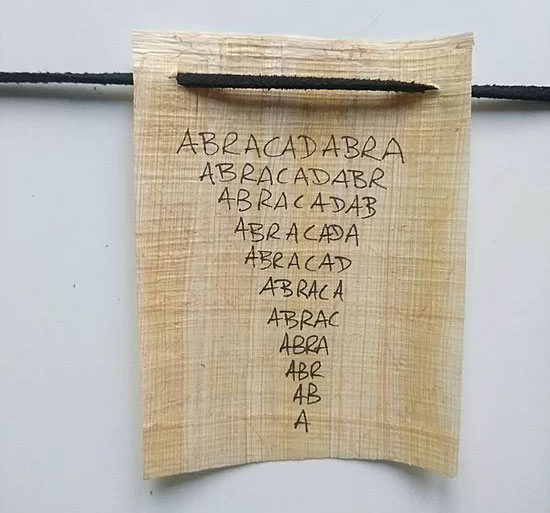Antiquity 'cure' for ancient Romans
The patient wears a paper with the words "Abracadabra" on his neck and prays for nine days in the belief that the disease will get better.
The Romans wrote the word "Abracadabra" on paper in principle, one word per line, one line at a time until a single letter stopped. The patient then ties the paper, carefully wraps it in linen, and puts it on his neck like a charm. After nine days, the patient looked for a river to the East, stood with his back turned and threw the charm over his shoulder. Through observation, the ancient Romans discovered that people with malaria often lived around humid, swampy areas near the river. Therefore, they believe that letting the talisman flow along the stream helps to block the "toxic wind" that causes disease.
The evidence of DNA testing from ancient Roman teeth suggests that malaria, which occurred in Rome in 450 BC, became one of the leading causes of death. However, the ancient Romans did not have a basic understanding of malaria at that time, they believed that the disease was created by the evil hand, so it was necessary to pray for the gods to cure the disease. The Abracadabra talisman was immediately accepted by the physicians and people as an effective treatment for malaria. Emperor Caracalla was the first to wear a talisman without even getting sick. He believes that talisman helps him prevent malaria, as well as many other diseases.

Talismans Abracadabra.(Photo: Roman Magic).
This cure quickly spread throughout the Roman Empire, people of all walks of life eagerly spend money to buy the Abracadabra talisman in the hope of being cured of malaria, or do not want the disease to visit. The two emperors who succeeded Caracalla, King Geta and Severus Alexander also continued to apply this superstitious treatment.
From a malarial mantra, "Abracadabra" became more widely known as "protecting health" , used for more than one purpose and became popular in European countries.
During the Black Death Pandemic in London (1665 - 1666) that claimed more than 100,000 lives, many believed that they could prevent the plague from entering the home by writing the spell "Abracadabra" on the door. Of course, this approach does not make sense scientifically. However, it seems to add hope for healing people in the context of the whole country is desperate because the disease is raging.
Science has finally proven that malaria is not caused by magic. In 1898, scientist Ronald Ross discovered the malaria parasite in the mosquito's digestive tract, proving that it was transmitted by mosquitoes, opening up many scientific and modern treatments. The cure for malaria with the Abracadabra charm gradually disappeared. Today, "Abracadabra" is a familiar saying of Western magicians who say when " doing magic".
- Funny death of ancient Romans
- How to help Romans have beautiful white teeth without toothpaste
- The diet of 'sea breeze' of ancient Romans
- Shocking discovery of the 2.3kg hand of the Romans
- The culprit makes us infected with worms, lice are ... ancient Romans
- The secret of strong teeth of ancient Romans
- Treasures Viking 1,200 years old revealed under the neck
- Ancient Romans were the agents of climate change in Europe 2,000 years ago
- Great architectural inventions of the Romans
- Reconstruction of the ancient
- How did the ancient Romans create heating systems?
- Colisée Arena
 13 causes of non-itchy rash
13 causes of non-itchy rash How the mouse with human ears changed the world?
How the mouse with human ears changed the world? The truth about 'fried rice syndrome!
The truth about 'fried rice syndrome! What is dental implant?
What is dental implant?